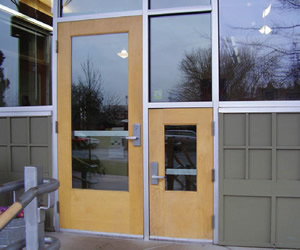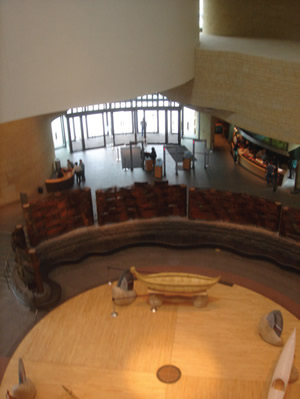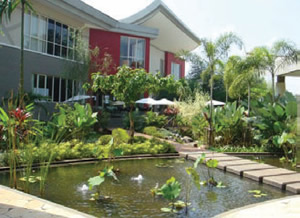Crime Prevention Through Environmental Design (CPTED)

PHOTO COURTESY OF FIELDING NAIR INTERNATIONAL
Crime prevention through environmental design (CPTED, pronounced “sep-ted”) is an essential approach to building functional, safe environments, drawing on basic concepts that can be easily learned and applied to any environment, including schools. Basic enough that by the end of this article you’ll have a good handle on it. Essential enough that to build schools without applying CPTED should be considered architectural malpractice.
Functional schools are conducive to teaching and learning. Safe schools design out unnecessary hazards and reinforce prosocial behaviors. Fortunately, functionality and safety usually go hand in hand.
Basic CPTED looks at natural surveillance (the ability to see what’s going on,) natural access control (the ability to decide who gets in, coupled with the need to maintain emergency egress,) and territoriality (the ability to establish who is in charge.) Territoriality is reinforced with good maintenance — evidence that somebody cares about the facility. All of this is enhanced with a Second Generation CPTED emphasis on connectivity — how well people are connected to each other, to the school and to the environment. If people care about each other and the facility, they are less inclined to engage in antisocial behaviors. Communication devices, ranging from cell phones to panic buttons, make it easier to share information, such as warnings about threats of violence or details regarding crimes in progress.

PHOTO COURTESY OF FIELDING NAIR INTERNATIONAL
Diagnosis / CPTED Planning
To quickly determine whether a school has weaknesses that can be addressed through CPTED, overlay a focus on the basics listed above with answers to the following key questions.
1. Can you spot approaching threats? (surveillance)
A sharp receptionist may be your best defense. Why? Because of all of your staff, they are the one most likely to be in a position to keep an eye on any approaching threats, and to sound the alarm. To best provide this service, the front office receptionist should have a direct view of as wide a swath of the entry area as possible, including people approaching the school, visitors at the front door and visitors inside the main lobby. Surveillance can be natural, electronic, or a combination of the two. Any areas not directly visible should be easily observed via security cameras, feeding images to a dedicated monitor located within the normal view of the receptionist. A more sophisticated arrangement will feed images to a secure cloud site, easily accessed via wireless handheld devices carried by school resource officers and other staff members.
2. Is the receptionist effective as the “guardian at the gate?” (access control and territoriality)
Being able to see an approaching threat is one thing, being able to do something about it is another. Unless your receptionist is a retired Navy Seal, expecting them to be able to physically stop a serious threat is far from reasonable. A preferable approach would be to install lockable doors at both ends of the lobby and into the adjoining office, controlled by lockdown buttons at the receptionist’s desk. A video/audio combination intercom at the main entry can further empower the receptionist to observe and communicate with a potential visitor before buzzing them in.

PHOTO COURTESY OF FIELDING NAIR INTERNATIONAL
3. Can you easily restrict bad guys from entering via other portals? (access control and surveillance.)
Offenders may skip well-guarded main entries and look for alternatives, especially if they’re already familiar with the site. In most schools, they can simply join the flow of students between classes, slip in behind a delivery person or knock on a back door. Can staff see the bad guys coming, lock doors with the push of a button and alert the school to the threat? Or are they obliged to track down the custodian, who then has to run from door to door with a hex key?
4. Can students on playing fields be easily alerted, and subsequently flee back into the school, when a threat appears outside? (access, egress and communication)
Shooters are rare, but vicious dogs, gang fights, grudge matches and other threats are commonplace. Crowds can drown out announcements, so visual displays in combination with more conventional electronic public address systems may be prudent. Gym doors are commonly designed as one-way exits, with no features that allow re-entry in an emergency. Designate at least some doors for re-entry purposes, either left open while directly supervised or accessible with the use of proximity cards carried by responsible parties.
5. Does the design protect against threats that arise inside the school? (access, egress, communication)
Most shootings occur indoors, and most shooters are students, familiar with the school, and quite capable of smuggling weapons inside. If incidents do occur, how easily can teachers spread the word and keep the threat from spreading further? How bullet resistant are the adjacent walls and windows? Do teachers have to step into the hallway and insert a key in order to lock classroom doors? Are there secondary exits, through which to flee if necessary? Do teachers wear emergency pendants and, if they don’t, what other emergency communication devices are available?
6. What section of the school would function as a disaster shelter? (access)
Gymnasiums, theaters, hallways or basements are commonly adapted for this purpose, primarily because of their large capacity and lack of windows. Anticipate the possibility that they will be needed for this purpose not just by the student body during a crisis, but by the surrounding community during a natural disaster. Whatever space is utilized, convenient storage space for food, water, medication and blankets can enhance their functionality. (Work with your local Red Cross to determine needs.)

PHOTO COURTESY OF FIELDING NAIR INTERNATIONAL
No Way Out? Many classrooms are designed with only one way in or out. Unfortunately this means there is no escape path if the main door is blocked by a chemical spill, or fire, or is occupied by a threatening individual.
7. Does the design guide visitors to the correct entry point? (territoriality)
The parking lot and walkways should logically guide visitors to the correct point of entry, where they can be screened before gaining further access. Signs should be prominently on display, and should include maps and arrows as needed. The use of lights, color and icons can help make entry points easier to find. The point here is not just to make it easy for legitimate visitors to find the correct entry, but to make intruders who appear to be wandering in another direction stand out.
8. Are there visual obstacles inside? (surveillance)
Do you need an army of staff members to see all sections of the school? Every blind corner, open, unattended classroom, unlocked boiler room or architectural niche serves as a hidden area within which inappropriate behavior can occur. Cleared windows, new windows, chamfered corners, mirrors and cameras can help open areas up for viewing. Unattended rooms should be kept locked.
9. Are environmental and personal health awareness reflected in the design? (connectivity)
Do students have access to clean drinking water and bathroom facilities? Are energy sources transparent, making them more effective as teaching tools? Does the school make good use of solar exposure? Is the HVAC system functional, or do teachers have to prop open doors and windows for ventilation, compromising security? Are grounds maintained using the least toxic alternatives? Can students work cooperatively, applying science and math skills in planning a garden and growing their own food? Is there a water spigot conveniently located near a garden spot? Can students easily walk or bicycle to school? Are the grounds designed to support a variety of movement activities?

PHOTO COURTESY OF FIELDING NAIR INTERNATIONAL
10. Does the design enhance connectivity between schools, teachers, students and the community? (connectivity)
From the student perspective, what messages are conveyed by the architecture and the postings? How many posters tell students what not to do? How many cheer them on, reinforcing visions of success? Positive messages should far outweigh the negative. From the community perspective, does the school come across as a welcoming neighborhood treasure or as an unwelcoming fortress? One of the very tricky elements of school design is finding the right balance between community involvement through integrated use of space and student protection through isolation. One measure that can help is a design that allows wings of the school to be opened independently, while maintaining security over the remaining sections. Conventional or electronic display boards, placed logically, along with use of electronic social media, can keep families and community members informed about school activities, resources and needs without compromising security. Area residents should be a school’s greatest supporters, voting for bond measures and volunteering their time as mentors or guest teachers who may bring projects to the school. With a shift toward project-oriented teaching, are there flexible spaces amenable to special displays or workshop experiences? Are there large outer doors that can be opened in order to bring in large pieces of equipment? Is the design wheelchair-friendly?
School planning isn’t easy. Compromises can inadvertently undermine critical health and safety features. Errors can go undetected until too late, becoming apparent only after the cement is dry. Don’t let this happen to your school! Use this list — amended with your own priorities — and check it more than once during the design process.
This article originally appeared in the issue of .